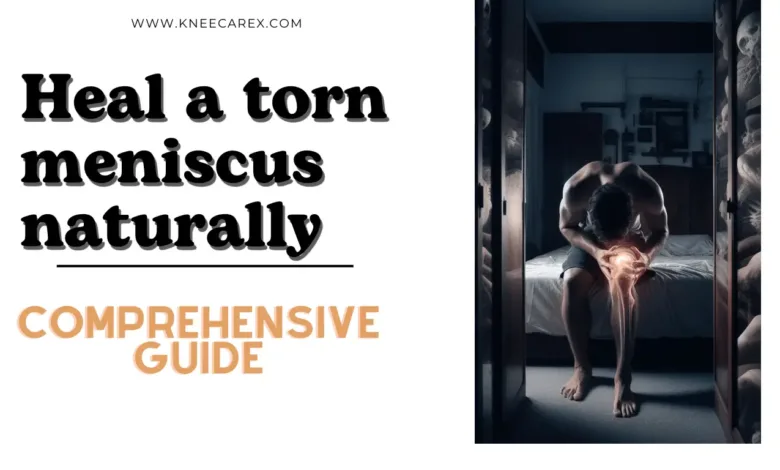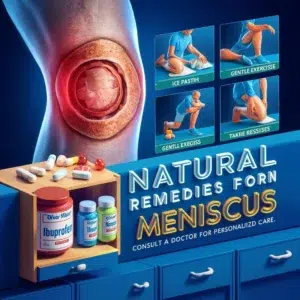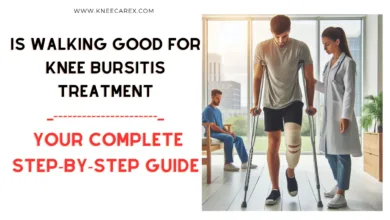How to Heal a Torn Meniscus Naturally | 5 Home Remittance

This blog will review how to heal a torn Meniscus naturally issue at home and with natural remedies to help reduce discomfort and speed up our objective is to offer you evidence-based, doable options for properly managing your illness that don’t just rely on drugs or intrusive surgeries. Stay tuned as we investigate safe, all-encompassing methods to assist you on your path to recovery.
how to doctor suggest heal a torn meniscus naturally
Contents
- 1 What is a Torn Meniscus?
- 2 5 Home Remedies to Help Heal a Torn Meniscus
- 3 1. Rest and Immobilization
- 4 2. Cold Therapy
- 5 3. Compression and Elevation
- 6 4. Over-the-Counter Medications
- 7 5. Gentle Exercises and Stretches
- 8 FAQ’s
- 8.1 How long does it take for a torn meniscus to heal without surgery?
- 8.2 How can I rebuild my meniscus naturally?
- 8.3 Can a tear in the meniscus repair itself?
- 8.4 What is the best remedy for a torn meniscus?
- 8.5 Is walking good for a torn meniscus?
- 8.6 Will a knee brace help a torn meniscus?
- 8.7 Can a meniscus tear heal on its own without surgery?
- 8.8 What happens if you don’t repair a torn meniscus?
- 8.9 What helps the meniscus heal faster?
- 8.10 What not to do with a torn meniscus?
- 8.11 Can a completely torn meniscus heal on its own?
- 8.12 What happens if a meniscus tear is left untreated?
- 8.13 How do you heal a torn meniscus naturally?
- 8.14 Is there a way to regrow the meniscus?
- 8.15 What vitamins help heal meniscus tears?
- 8.16 How do you fix a meniscus tear without surgery?
- 8.17 How to self-heal a meniscus tear?
- 8.18 How do you heal a meniscus tear naturally?
- 8.19 Can you fully recover from a meniscus tear?
- 8.20 Can a torn meniscus repair itself?
- 8.21 How do you heal a torn lateral meniscus naturally?
- 8.22 Can you heal a torn meniscus naturally?
- 8.23 How do you heal a torn meniscus naturally, Reddit?
- 8.24 How do you heal a strained meniscus naturally?
- 8.25 Can you heal a meniscus tear naturally?
- 8.26 Can you make a torn meniscus worse?
- 8.27 Do I Have a Meniscus Tear?
- 8.28 Do you want to learn how to heal a torn meniscus naturally?
- 8.29 Exploring Recovery: Can a Torn Meniscus Heal on Its Own Without Surgery?
- 8.30 How Can I Prevent a Meniscus Tear?
- 8.31 How Can You Tear Your Meniscus?
- 8.32 How Can the Meniscus Be Torn?
- 8.33 How Long Does It Take for a Torn Meniscus to Heal Without Surgery?
- 8.34 How Long Does a Torn Meniscus Take to Heal?
- 8.35 Is there a way to heal a torn meniscus naturally?
- 8.36 Is walking good for a meniscus tear?
- 8.37 Patients frequently ask: Can you rehab a torn meniscus without surgery?
- 8.38 So, what is the meniscus?
- 8.39 What Aggravates a Torn Meniscus?
- 8.40 What Are Meniscus Tear Symptoms?
- 8.41 What Are Some Ways To Heal Meniscus Tear Naturally?
- 8.42 What Are the Symptoms of a Torn Meniscus?
- 8.43 What Causes a Meniscus Tear?
- 8.44 What Does a Meniscus Tear Feel Like?
- 8.45 What Happens if You Don’t Repair a Torn Meniscus?
- 8.46 What Is a Torn Meniscus?
- 8.47 What are 3 signs of a meniscus tear in the knee?
- 8.48 What happens if a meniscus tear is left untreated?
- 8.49 What is a meniscus tear?
- 8.50 What is the Meniscus?
- 9 Conclusion: How to Heal a Torn Meniscus Naturally
What is a Torn Meniscus?

A torn meniscus can cause knee joint discomfort, edema, stiffness, and locking or catching sensations. The location and size of the tear within the meniscus can affect how severe the symptoms are. More giant tears can result in severe discomfort and functional limits, while more minor ones occasionally don’t show any signs.
You must see an orthopedic doctor if you think you may have a torn meniscus. In addition to doing a physical examination, they might prescribe imaging tests, such as an X-ray or MRI, to assess the degree of damage and rule out any additional problems.
Physical therapy to increase strength and flexibility, in addition to RICE (rest, ice, compression, and elevation) to control pain and swelling, are possible treatments for a torn meniscus. Based on the patient’s age, activity level, overall health, and the amount and location of the tear, surgical intervention may be required in certain circumstances to repair or remove the torn meniscus.
Recovery Times
In 4-6 weeks, less severe meniscus tears can heal with rest and physical therapy. Others might need surgery, and it might take up to six months to recuperate.
Doctors may recommend gentle activities for patients who cry less intensely.
These workouts are likely to cause some discomfort at first. But if any workout hurts, don’t continue.
5 Home Remedies to Help Heal a Torn Meniscus
In this blog post, we’ll look at five efficient DIY treatments that can help reduce symptoms and encourage recovery. These suggestions will supply you with doable ways to care for your ailment and restore your mobility, from easy exercises to all-natural cures. Talk with me about these tried-and-true strategies supported by medical professionals to assist you in becoming well.
1. Rest and Immobilization
I want to talk about how immobilization and rest are crucial for a torn meniscus to heal naturally. One frequent knee ailment that can cause a lot of pain and discomfort is a torn meniscus. Nevertheless, this damage can be recovered without surgery if the right care is given.
A torn meniscus heals best when the injured area is immobilized and rested. With this method, mobility and weight-bearing exercises are restricted to give the wounded area time to heal. A knee brace or crutches should be utilized during this time to lessen strain on the injured knee joint. More measures to reduce pain and swelling include using ice and taking over-the-counter anti-inflammatory drugs.
You can facilitate the body’s innate healing mechanism by immobilizing and resting the knee. Because of the meniscus’s restricted blood supply, healing can be difficult. However, you can foster an environment that is favourable to tissue regeneration and repair by minimizing movement and stress on the wounded area.
It is significant to remember that the length of rest and immobilization may differ based on personal circumstances and the extent of the injury. Your orthopedic physician will provide you with detailed instructions and advice regarding the best time frame for this course of treatment.
2. Cold Therapy
When it comes to repairing a torn meniscus, I frequently suggest cold therapy as an excellent natural remedy. This common knee injury can be made less painful and less inflammatory by applying ice or a cold pack to the injured knee. By narrowing blood vessels, cold therapy reduces the amount of inflammatory molecules that reach the affected area and, as a result, lessens the body’s inflammatory reaction. It’s crucial to apply cold therapy sporadically throughout the early stages of an injury, for 15 to 20 minutes every few hours. Regular use of cold treatment can facilitate quicker healing and increased mobility, resulting in a more seamless recuperation process.
3. Compression and Elevation
We’ll talk about the best way to mend a torn meniscus naturally, emphasizing the value of compression and elevation in particular. In my opinion, as an orthopedic physician, non-invasive methods should always be investigated, and these two methods can be very helpful in the healing process.
Compression is a technique that helps lessen discomfort and swelling by gently pressing on the affected area. This can be accomplished by applying a compression bandage or knee sleeve; by preventing the build-up of extra fluid, compression helps to reduce inflammation and accelerate recovery.
On the other hand, elevation is a straightforward yet efficient way to control swelling. Gravity helps drain extra fluid away from the injured knee by keeping it raised above the level of the heart. This can be achieved by sitting or lying down and placing the leg on a stack of pillows or a footrest.
To reduce the discomfort brought on by a torn meniscus, compression, and elevation work together to foster a healing environment. It’s crucial to remember that, as advised by your healthcare professional, these methods should be used in conjunction with other conservative treatments, including rest, ice application, and suitable exercise.
4. Over-the-Counter Medications

However, because NSAIDs can have adverse effects, it’s important to follow dosage guidelines and speak with a doctor, especially if using them for an extended period. In addition to medication, the healing process may be aided by rest, ice application, and mild exercise. Keep in mind that each case is different, and consulting a physician is necessary to decide the best course of action.
5. Gentle Exercises and Stretches
We’ll concentrate on low-impact activities that strengthen the muscles around the joints, lessen inflammation, and increase joint mobility—all without placing undue strain on the injured area. We’ll talk about safe ways to include quadriceps strengthening exercises, hamstring stretches, and mild knee bends into your recuperation regimen.
Additionally, we will highlight the necessity of appropriate technique and progressive progression to prevent further injury and guarantee long-term knee health. Without invasive surgical treatments, many people can find relief and restore functional mobility by adhering to an organized rehabilitation plan and changing their lifestyle.
FAQ’s
How long does it take for a torn meniscus to heal without surgery?
The time it takes for a torn meniscus to heal without surgery varies based on the severity of the tear and individual healing capabilities. With RICE therapy (rest, ice, compression, and elevation), minor tears can heal in a few weeks, while larger tears may take several months.
How can I rebuild my meniscus naturally?
There is no guaranteed natural way to rebuild a meniscus once it’s torn. However, maintaining a healthy weight, doing low-impact exercises to strengthen the muscles around the knee, and maintaining a healthy, vitamin- and mineral-rich diet help support overall knee health.
Can a tear in the meniscus repair itself?
Yes, small tears in the meniscus can sometimes heal on their own, especially in younger individuals with good blood supply to the area. However, larger tears or tears in the inner two-thirds of the meniscus often require surgical intervention.
What is the best remedy for a torn meniscus?
The best remedy for a torn meniscus depends on the severity of the tear. Initially, rest, ice, compression, and elevation (RICE therapy) can help reduce pain and swelling. Physical therapy to strengthen the muscles around the knee may also be beneficial. In some cases, surgery may be necessary.
Is walking good for a torn meniscus?
Walking can be beneficial for a torn meniscus, but it’s essential to listen to your body. If walking causes significant pain or discomfort, it’s best to avoid activities that aggravate the injury. Low-impact exercises like swimming or cycling may be better options during the healing process.
Will a knee brace help a torn meniscus?
A knee brace can provide support and stability to the knee, which may help reduce symptoms of a torn meniscus. However, it’s essential to consult with a healthcare professional to determine the most appropriate brace for your specific injury and to ensure proper fit and usage.
Can a meniscus tear heal on its own without surgery?
Yes, some meniscus tears, especially small ones, can heal on their own without surgery. However, larger tears or tears in areas with poor blood supply may not heal without surgical intervention.
What happens if you don’t repair a torn meniscus?
If a torn meniscus is not repaired, it can lead to persistent pain, swelling, and limited mobility in the knee. Over time, untreated meniscus tears can also increase the risk of developing osteoarthritis in the affected knee.
What helps the meniscus heal faster?
To help a meniscus heal faster, it’s essential to follow the RICE protocol (rest, ice, compression, elevation) initially to reduce pain and swelling. Physical therapy exercises to strengthen the muscles around the knee can also promote healing and improve knee function.
What not to do with a torn meniscus?
Avoid activities that put excessive strain on the knee, such as running, jumping, or twisting motions. It’s also important not to ignore symptoms or delay seeking treatment, as this can worsen the tear and prolong the healing process.
Can a completely torn meniscus heal on its own?
A completely torn meniscus is less likely to heal on its own, especially in the inner two-thirds of the meniscus, where blood supply is limited. Surgical intervention may be necessary to repair or remove the torn portion of the meniscus.
What happens if a meniscus tear is left untreated?
If a meniscus tear is left untreated, it can lead to chronic knee pain, swelling, and stiffness. Over time, untreated meniscus tears can also increase the risk of developing osteoarthritis in the affected knee.
How do you heal a torn meniscus naturally?
Healing a torn meniscus naturally involves rest, ice, compression, and elevation (RICE therapy) to reduce pain and swelling. Strengthening exercises for the muscles around the knee and maintaining a healthy lifestyle may also help support healing.
Is there a way to regrow the meniscus?
Currently, there is no proven way to regrow meniscus tissue once it’s damaged. However, researchers are exploring regenerative medicine techniques such as stem cell therapy and platelet-rich plasma (PRP) injections as potential treatments for meniscus injuries.
What vitamins help heal meniscus tears?
Vitamins that may help support the healing of a meniscus tear include vitamin C, which is important for collagen synthesis, and vitamin D, which is important for bone health. However, it’s essential to consult with a healthcare professional before taking any supplements to ensure they are safe and appropriate for your specific injury.
How do you fix a meniscus tear without surgery?
Fixing a meniscus tear without surgery may be possible for small tears in the outer edge of the meniscus with good blood supply. This can be achieved through conservative treatments such as rest, physical therapy, and anti-inflammatory medications to reduce pain and swelling.
How to self-heal a meniscus tear?
Self-healing of a meniscus tear involves following a conservative treatment plan that includes rest, ice, compression, and elevation (RICE therapy), as well as gentle stretching and strengthening exercises for the muscles around the knee. It’s essential to listen to your body and avoid activities that worsen symptoms.
How do you heal a meniscus tear naturally?
To heal a meniscus tear naturally, it’s important to follow a conservative treatment plan that includes rest, ice, compression, and elevation (RICE therapy) to reduce pain and swelling. Physical therapy exercises to strengthen the muscles around the knee can also help support healing.
Can you fully recover from a meniscus tear?
The extent of recovery from a meniscus tear depends on the severity of the tear and the individual’s response to treatment. With appropriate care and rehabilitation, many people can fully recover from a meniscus tear and return to their normal activities.
Can a torn meniscus repair itself?
In some cases, a torn meniscus can repair itself, especially in younger individuals with good blood supply to the area. However, larger tears or tears in areas with poor blood supply may not heal without surgical intervention.
How do you heal a torn lateral meniscus naturally?
Healing a torn lateral meniscus naturally involves following a conservative treatment plan that includes rest, ice, compression, and elevation (RICE therapy) to reduce pain and swelling. Physical therapy exercises to strengthen the muscles around the knee can also help support healing.
Can you heal a torn meniscus naturally?
While some meniscus tears can heal on their own, especially small tears in areas with good blood supply, larger tears or tears in areas with poor blood supply may require surgical intervention to heal fully.
How do you heal a torn meniscus naturally, Reddit?
On Reddit, you may find anecdotal accounts and advice from individuals who have experienced meniscus tears. However, it’s important to consult with a healthcare professional for personalized advice and treatment options.
How do you heal a strained meniscus naturally?
To heal a strained meniscus naturally, it’s important to follow a conservative treatment plan that includes rest, ice, compression, and elevation (RICE therapy) to reduce pain and swelling. Physical therapy exercises to strengthen the muscles around the knee can also help support healing.
Can you heal a meniscus tear naturally?
They can heal on their own, especially small tears in areas with good blood supply; more giant tears or tears in areas with poor blood supply may require surgical intervention to heal fully.
Can you make a torn meniscus worse?
Yes, certain activities or movements, such as twisting or pivoting on the affected knee, can worsen a torn meniscus. It’s important to avoid activities that aggravate the injury and follow a treatment plan prescribed by a healthcare professional.
Do I Have a Meniscus Tear?
If you are experiencing symptoms such as knee pain, swelling, and limited range of motion, you may have a meniscus tear. However, a definitive diagnosis can only be made by a healthcare professional after a thorough evaluation.
Do you want to learn how to heal a torn meniscus naturally?
Healing a torn meniscus naturally involves following a conservative treatment plan that includes rest, ice, compression, and elevation (RICE therapy) to reduce pain and swelling. Physical therapy exercises to strengthen the muscles around the knee can also help support healing.
Exploring Recovery: Can a Torn Meniscus Heal on Its Own Without Surgery?
Yes, some meniscus tears, especially small ones in areas with good blood supply, can heal on their own without surgery. However, larger tears or tears in areas with poor blood supply may require surgical intervention.
How Can I Prevent a Meniscus Tear?
To prevent a meniscus tear, it’s important to maintain strong muscles around the knee through regular exercise and stretching. Using proper techniques during physical activities and avoiding sudden, jerky movements can also help reduce the risk of injury.
How Can You Tear Your Meniscus?
A meniscus tear can occur due to a sudden twist or pivot of the knee, often during sports or physical activities. Degenerative changes in the meniscus due to aging or wear and tear can also increase the risk of tearing.
How Can the Meniscus Be Torn?
The meniscus can be torn through traumatic injury, such as a sudden twist or pivot of the knee, or through degenerative changes that weaken the meniscus over time. Certain activities or movements that put a strain on the knee can also contribute to tearing.
How Long Does It Take for a Torn Meniscus to Heal Without Surgery?
The time it takes for a torn meniscus to heal without surgery varies based on the severity of the tear and individual healing capabilities. Minor tears may heal in a few weeks with rest, ice, compression, and elevation (RICE therapy), while larger tears may take several months.
How Long Does a Torn Meniscus Take to Heal?
The time it takes for a torn meniscus to heal depends on the severity of the tear and the individual’s response to treatment. Minor tears may heal in a few weeks with rest and conservative measures, while larger tears or tears in areas with poor blood supply may take longer to heal.
Is there a way to heal a torn meniscus naturally?
While some meniscus tears can heal on their own, especially small tears in areas with good blood supply, larger tears or tears in areas with poor blood supply may require surgical intervention to heal fully.
Is walking good for a meniscus tear?
Walking can be beneficial for a meniscus tear, but it’s important to listen to your body and avoid activities that worsen symptoms. If walking causes significant pain or discomfort, avoid it until the tear has healed.
Patients frequently ask: Can you rehab a torn meniscus without surgery?
Yes, rehabilitation exercises can help strengthen the muscles around the knee and improve knee stability, which may reduce symptoms and improve function in some cases of meniscus tears. However, the effectiveness of rehabilitation depends on the severity and location of the tear.
So, what is the meniscus?
The meniscus is a C-shaped piece of cartilage in the knee that acts as a cushion between the thighbone (femur) and shinbone (tibia). It helps absorb shock and distribute weight evenly across the knee joint.
What Aggravates a Torn Meniscus?
Activities that put a strain on the knee, such as twisting, pivoting, or deep squatting, can aggravate a torn meniscus and cause increased pain and swelling. It’s important to avoid these activities while the meniscus is healing.
What Are Meniscus Tear Symptoms?
Symptoms of a meniscus tear can include knee pain, swelling, stiffness, and a popping sensation at the time of injury. Some people may also experience locking or catching of the knee joint.
What Are Some Ways To Heal Meniscus Tear Naturally?
To heal a meniscus tear naturally, it’s important to follow a conservative treatment plan that includes rest, ice, compression, and elevation (RICE therapy) to reduce pain and swelling. Physical therapy exercises to strengthen the muscles around the knee can also help support healing.
What Are the Symptoms of a Torn Meniscus?
Symptoms of a torn meniscus can include knee pain, swelling, stiffness, and a popping sensation at the time of injury. Some people may also experience locking or catching of the knee joint.
What Causes a Meniscus Tear?
A meniscus tear can be caused by a sudden twist or pivot of the knee, often during sports or physical activities. Degenerative changes in the meniscus due to aging or wear and tear can also increase the risk of tearing.
What Does a Meniscus Tear Feel Like?
A meniscus tear can cause knee pain, swelling, and stiffness. Some people may also experience a popping sensation at the time of injury. In some cases, the knee may also feel like it’s locking or catching.
What Happens if You Don’t Repair a Torn Meniscus?
If a torn meniscus is not repaired, it can lead to persistent pain, swelling, and limited mobility in the knee. Over time, untreated meniscus tears can also increase the risk of developing osteoarthritis in the affected knee.
What Is a Torn Meniscus?
A torn meniscus is a common knee injury that occurs when the cartilage in the knee is torn. This can cause pain, swelling, and stiffness in the knee joint, as well as a range of other symptoms.
What are 3 signs of a meniscus tear in the knee?
Three signs of a meniscus tear in the knee include knee pain, swelling, and stiffness. Some people may also experience a popping sensation at the time of injury or locking or catching of the knee joint.
What happens if a meniscus tear is left untreated?
Untreated meniscus tears can result in persistent knee stiffness, edema, and pain. Osteoarthritis in the affected knee might also increase as a result of untreated meniscus tears over time.
What is a meniscus tear?
A common injury to the knee that results from a tear in the cartilage is a meniscus tear. Along with a number of other symptoms, this may result in knee joint discomfort, edema, and stiffness.
What is the Meniscus?
A C-shaped section of cartilage in the knee, the meniscus serves as a cushion between the tibia and femur, the shinbones. It aids in uniform weight distribution and stress absorption.
Conclusion: How to Heal a Torn Meniscus Naturally
In conclusion, a thorough approach and patience are necessary for the natural healing of a torn meniscus. Rest and ice therapy can help reduce discomfort and swelling, but low-impact activities like swimming, cycling, and meniscus-friendly stretches can help build strength and mobility over time. You can also lessen swelling and accelerate recovery by including anti-inflammatory items in your diet, like fatty fish, turmeric, and ginger.
Recall that seeking the advice of an orthopaedic professional is essential for an accurate diagnosis and customized treatment regimens since severe instances might necessitate surgery. A torn meniscus can be successfully healed by many with commitment and a comprehensive approach when using natural approaches.




